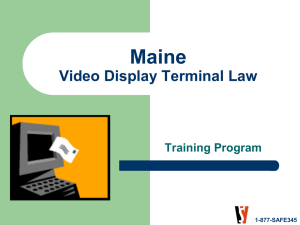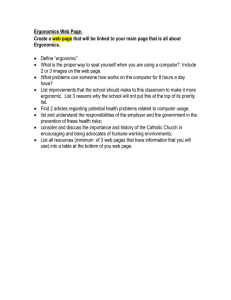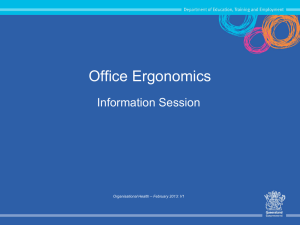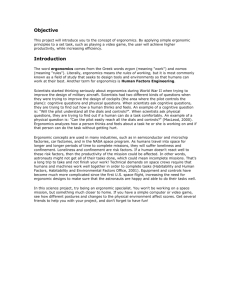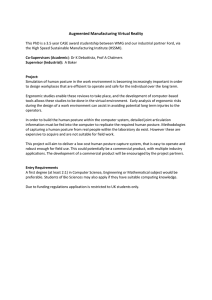View VDT Presentation in PDF
advertisement
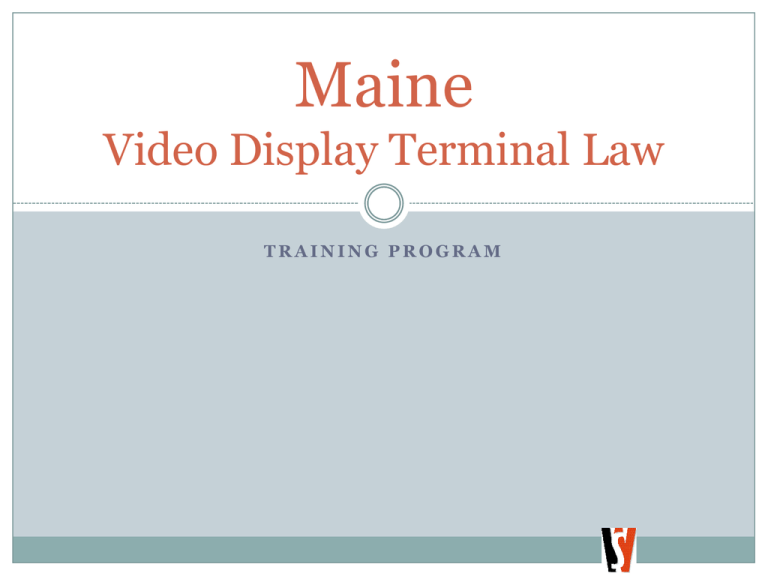
Maine Video Display Terminal Law TRAINING PROGRAM By the end of this presentation you will be able to: Understand ergonomics and its benefits Recognize signs and symptoms of early injury Identify work activities that can lead to injury List examples of ergonomic principles that reduce risk of injury Conduct an a workstation evaluation Maine VDT Law MRSA Title 26 – Labor and Industry Chapter 5 – Health and Safety Regulations Sections: 251 and 252 – Video Display Operator Effective date: January 1, 1992 Section: 251 Definitions Bureau – Bureau of Labor Standards Employer – Uses 2 or more terminals Operator – Four consecutive hours daily Terminal – Video display terminal (Does not apply to television, oscilloscopes, cash registers, or money typewriters) Section: 252 Education Training requirements Under 5 employees MAY be only written 6 employees or more MUST be oral and written Training schedule Within the first month of hire Annually thereafter Training Program Requirements Notification of rights by posting the law and poster that explains these rights and duties in plain language. (available from Bureau of Labor standards – 623-7900) Explanation of the proper use of the terminals Protective measures to avoid symptoms How to achieve and maintain proper posture How to adjust your workstation equipment Definition of Ergonomics Ergonomics: It is the science and practice of designing jobs and workplaces to match the capabilities and limitations of the human body Ergonomics means: fitting the job to the worker, NOT the worker to the job Benefits of Ergonomics Ergonomics helps to prevent musculoskeletal injuries Ergonomics has other benefits: Improved quality of work Improved quality of life Reduced fatigue and discomfort Safety, Health and the VDT Law Education on injury prevention is an important part of safety and health There are thousands of injuries, known as WMSD’s, in Maine each year (WMSD: Work-related Musculo-Skeletal Disorders) What are Work-related Musculo-Skeletal Disorders (WMSD’s) Also known as: Cumulative Trauma Disorders Repetitive Strain Injuries Overuse Injuries Usually develop gradually, but sometimes can appear suddenly Can be serious, if not taken care of early What are Symptoms of WMSD’s? Discomfort, pain, dull ache Decreased range of motion, tightness Numbness, tingling Change of color Swelling of joint or limb Decreased grip strength What Causes WMSD’s? Repetitive motion Nutritional deficiencies Forceful exertion Poor lighting Awkward posture Prolonged standing in one Mechanical pressure place Sitting (poor posture) Working with neck flexed Cold temperatures Stress Will it happen to me? Age General health Heredity Posture Diet Activities WMSD Injury Depends On! Duration of exposure (how long) – usually need hours of exposure before risk factors become a concern. Frequency of exposure (how often) Intensity of exposure (how much) Combinations of factors Awkward Postures Over Reaching Awkward Postures Awkward Postures Solutions: Static Postures Foot rests, shifting weight Well designed, adjustable, supportive seating Work surfaces at appropriate height Change positions frequently Routine stretch breaks Neutral Posture Head centered over shoulders 90° angle for arms 90° angle for legs 90° angle for torso Solutions: The Chair The right size Lumbar support Proper height Armrests (removable) Pan Good foundation Adjustable while sitting or seated Seated neutral posture Adjustments Backrest Lumbar support Seat Height Foundation Armrest Armrests Base of Chair 5 point suspension Most office chairs that are manufactured today come with twin wheel nylon wheeled casters. This type of caster, specifically the nylon wheel, is fine for carpeting but will mark and scratch hard floors. This happens because the nylon wheels don’t roll, they slide. When they slide, they mark the floor. Our Elite chair casters are the perfect solution for this problem. The wheels on these casters will not mark the floors under normal operation. Shoulders Proper Position Improper Position Solution: The Monitor The monitor should be directly in front of you Top of screen should be eye level A copy stand should be adjacent to or in front of the monitor Adjust brightness and contrast Monitors Options External keyboard Space saver External mouse Low glare Monitor Riser Up and back Down and forward Up in place Glare Placement Not good Not good Solution: The Keyboard Spread keyboard work throughout the day Use macros for common functions Take stretch pauses Improve your posture and move around as much as possible OSHA Keyboard Trays No lever Difficult places Keyboard swivels For curves Knee clearance Keyboards Wrist bent to side Wrist bent upward Alternatives Wrists Poor Hand/Wrist Placement Proper Hand/Wrist Placement Compromise Chair Adjustment Proper Keyboard height Document Holder Sit/Stand Monitor Stand Foot Rest Mouse / Pointer Alternatives Support Mouse Placement Mouse Placement Monitor Solution: Lighting Bright lighting may “wash out” the image making it hard to see which will cause eye fatigue. Lighting should be indirect or “task lighting” should be used to reduce wash out or glare. Solution: Glare Screen 90o angle to window Drapes or blinds Avoid bright lights Screen hood Walls, work surfaces non-reflective Keep screen clean Adjust color, contrast, and brightness Solutions: Workspace and Other Devices Document holder Workspace Document holders Office Environment Telephones Stretching Office Environment Shoulder rest Climate Control Headset Where Should it Be? Document Holders Choices Okay Best Telephones Talking Not good Very good Work Area Organizers Many different styles to suit your personal needs Organizers Stretches Relieves static posture Keeps fluids circulating Prevents toxins from building up in tissues Change Positions Sharing Workstations Stress What Can You Do? Recognize and report symptoms Get involved in ergonomics Perform an Ergonomic Risk Assessment Ergonomic Risk Assessment Identify the Hazards – use the attached checklist. Assess the Risk – how often do you do your job, your health, posture, workstation evaluation (attached). Control the risks – Adjust your workstation to fit your ergonomic needs. Why is it Important to Report Symptoms? Chronic symptoms can lead to disabling injuries, even surgery Early treatment is more successful Work Process Even when the workstation design and environmental factors are at their best, a worker can suffer discomfort and injuries from factors related to the work process. Five Key Points to Remember Ergonomics can help you on your job and at home WMSD’s can happen in jobs with risk factors Risk factors can be reduced and WMSD’s prevented Reporting symptoms early is important You can help by following good ergonomic practices Getting Assistance Your supervisor MDOL/Bureau of Labor Standards Telephone No. 624-6400 Fax No. 624-6449 http://www.safetyworksmaine.org Keys to Your Good Work -Publication OSHA – http://www.osha.gov/SLTC/etools/computerwork stations/index.html OSHA – www.OSHA.gov Opinion Opinion Opinion Opinion Does a ball make you sit upright or prevent unhealthful, uncomfortable sitting position? Can you sit upright or not? Is it the ball or you that determines what you do with your own body. Opinion Opinion Opinion Opinion Opinion What to look for
